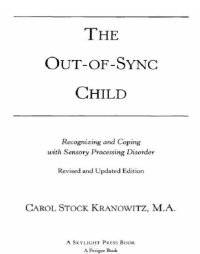
Ebook: The out-of-sync child: recognizing and coping with sensory processing disorder
Author: Kranowitz Carol Stock
- Tags: Minimal brain dysfunction in children, Perceptual-motor learning, Sensorimotor integration, Electronic books
- Year: 2006
- Publisher: Penguin USA Inc.
- City: New York
- Language: English
- epub
pt. I. Recognizing sensory processing disorder -- 1. Does your child have sensory processing disorder? -- Four out-of-sync children at home and school -- Sensory processing disorder : a brief definition -- Common symptoms of SPD -- What SPD is not : "look-alike" symptoms -- Associated problems -- Possible causes of SPD -- Who has sensory processing disorder? -- Don't we all experience sensory processing problems? -- Sample sensory-motor history questionnaire -- Hope is at hand -- 2. Understanding sensory processing, and what can go amiss -- The senses -- What is sensory processing? -- The typical development of sensory processing in infants and children -- So, what is sensory processing disorder? -- Six important caveats -- Comparison of typical sensory processing and sensory processing disorder -- 3. How to tell if your child has a problem with the tactile sense -- Three kindergartners at circle time -- The smoothly functioning tactile sense -- The out-of-sync tactile sense -- How the tactile sense affects everyday skills -- Characteristics of tactile dysfunction -- 4. How to tell if your child has a problem with the vestibular sense -- Two first-graders at the amusement park -- The smoothly functioning vestibular sense -- The out-of-sync vestibular sense -- How the vestibular sense affects everyday skills -- Characteristics of vestibular dysfunction -- 5. How to tell if your child has a problem with the proprioceptive sense -- One nine-year-old at the swimming pool -- The smoothly functioning proprioceptive sense -- The out-of-sync proprioceptive sense -- How the proprioceptive sense affects everyday skills -- Characteristics of proprioceptive dysfunction -- 6. How to tell if your child has a problem with the visual sense -- Two seventh-graders at school -- The smoothly functioning visual sense -- The out-of-sync visual sense -- Characteristics of visual dysfunction -- 7. How to tell if your child has a problem with the auditory sense -- A third-grader in music class -- The smoothly functioning auditory sense -- The out-of-sync auditory sense -- Characteristics of auditory dysfunction.;pt. II. Coping with sensory processing disorder -- 8. Diagnosis and treatment -- A parent's search for answers -- Recognizing when your child needs professional help -- Documenting your child's behavior -- Diagnosing the problem -- Different therapies, different approaches -- Bringing therapist and child together -- Keeping a record -- 9. Your child at home -- A parent's revelation -- A balanced sensory diet -- Promoting healthy sensory processing at home -- 10. Your child at school -- What a difference communication makes! -- If only school were more like home -- Deciding whom to tell -- A good school-and-child match -- Promoting your child's success at school -- 11. Coping with your child's emotions -- A typically dreadful morning -- Other experts' advice -- Dos and don'ts for coping -- 12. Looking at your child in a new light -- A parent's epiphany -- Becoming enlightened -- A parent's encouraging words -- Appendix A. The sensory processing machine -- Appendix B. Dr. Ayres's four levels of sensory integration -- Glossary.;Provides an overview of Sensory Integration Dysfunction, discussing how it affects children's behavior; and features criteria and guidance for getting a diagnosis and treatment, as well as advice on how parents can deal with the problem at home.
Download the book The out-of-sync child: recognizing and coping with sensory processing disorder for free or read online
Continue reading on any device:

Last viewed books
Related books
{related-news}
Comments (0)